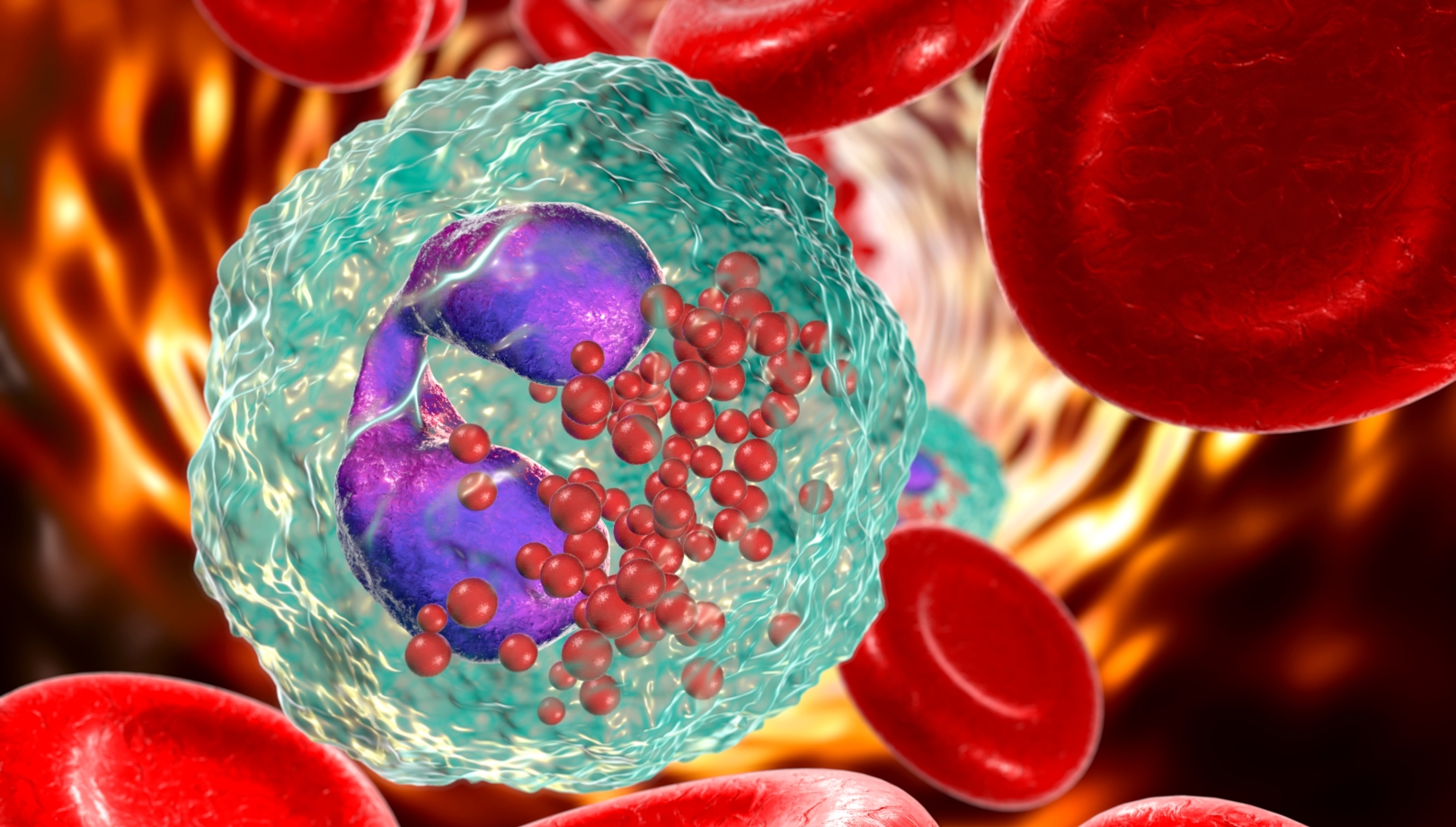How do you kill intestinal parasites
How do you kill intestinal parasites |
| Asthma-causing blood cells could help fight colon cancer - ISRAEL21c Posted: 26 Feb 2019 11:04 PM PST  A surprising new study from Israel finds that malignant colorectal cancer cells can be eliminated with eosinophils — white blood cells that originate in bone marrow and may once have killed off intestinal parasites, but which today are responsible for chronic asthma and allergies. The research, published in Cancer Immunology Research on January 21, was led by Prof. Ariel Munitz of the Tel Aviv University Sackler School of Medicine department of microbiology and clinical immunology and conducted by his doctoral student Hadar Reichman, in collaboration with colleagues in Tel Aviv Medical Center's gastroenterology department. "Eosinophils are white blood cells that secrete powerfully destructive proteins," Munitz said. "They may have played an evolutionary role in combating parasites. But now that most people, particularly in the West, enjoy good hygiene and few parasites, the eosinophils have become destructive agents, causing allergies and asthma. "Our new research theorized that since eosinophils are capable of killing parasites and can cause damage in the lungs of asthma patients, they might play a role in cancer treatment and would be able to kill tumor cells." The largest eosinophil reservoir is situated in the digestive system, so the researchers initially decided to test their theories on colorectal cancer. In the first stage of research, they selected samples from tumors of 275 patients to determine the number of eosinophils in a tumor as compared with the stage and severity of the disease. "We found that the higher the number of eosinophils in the tumor, the less severe the disease, which represents a clear correlation," said Munitz. "We identified that the cancerous environment attracts these cells, which infiltrate the tumors and flourish there for a long time." Potent anti-tumor activities The researchers subsequently tested their hypotheses in various mouse models of colorectal cancer. They discovered that eosinophils displayed potent anti-tumor activities and could directly kill tumor cells. "We also found that when eosinophils were activated by a protein called IFN-gamma, they induced an even greater tumor-killing response," Munitz explained. "Following various extensive analyses, we concluded that eosinophils have unique and distinct activities in comparison with other cells present in the tumor. For example, eosinophils can kill tumors independently of known tumor-fighting cytotoxic T cells." He believes eosinophils could be used in treating cancer if their robust anti-tumor response somehow could be unleashed pharmaceutically, or by combining treatments to harness the potent forces of both eosinophils and cytotoxic T cells. "We have discovered a new target for immunotherapy for cancer patients — the eosinophils," concluded Munitz. "We hope that our research will serve as a foundation for drug development in a number of different approaches." The study was supported by the Israel Cancer Research Foundation, the Israel Cancer Association and the Israel Science Foundation. |
| We Need to Talk about Intestinal Worms - Scientific American Posted: 29 Jan 2019 12:00 AM PST  In 1909, John D. Rockefeller, Sr., deeded 72,000 shares of the Standard Oil Company to establish a foundation dedicated to the promotion of health and the reduction of disease. Hookworm, then rampant throughout the U.S. South, was the Rockefeller Foundation's first undertaking. The parasite latches onto the wall of its host's small intestine, causing iron and protein deficiencies, stunted physical and cognitive growth and profound lethargy. Now, 110 years later, where does hookworm stand? How much progress has been made, and what work remains? In many ways, the Rockefeller Sanitary Commission for the Eradication of Hookworm Disease (RSC) set the standard for public health programs to map, treat, educate, scale up, work with other sectors (in hookworm's case, water, sanitation and hygiene) and collaborate with local leaders in government, media, churches and schools. And while technology has advanced, the intent is unchanged. The RSC's educational silent films and country fair exhibits have given way to TED talks and text-message alerts, but all are used to raise awareness and encourage preventive behavior. Today, smartphones and satellites are used to map hookworm's location, replacing the surveys and voluntarily mailed-in stool samples that the RSC relied on. One can only imagine what devices will be available for mapping diseases 110 years from now. Some aspects of the anti-hookworm effort have undergone paradigm shifts. Regarding treatment, the RSC aimed to make the host environment inhospitable for the parasite, through ingestion of potential poisons (extract of male fern or thymol with Epsom salts). By contrast, modern treatments target the worms instead of the human. The drugs albendazole and mebendazole can disrupt adult hookworms' metabolism and reproduction, most often with little to no side effects in the host. In the past, infected people repeated treatments until their stools were worm-free. Moreover, the RSC treated infected individuals one at a time; now entire districts, regions, even nations receive deworming medicine via regularly scheduled mass drug administrations. Then and now, treatment is combined with strong efforts to improve sanitation and hygiene. By the 1930s (much later than the RSC had anticipated), hookworm had declined in the South in large part because fewer people were exposed to the parasite, thanks to more indoor plumbing, paved roads, farming machinery (which took people out of the fields) and an overall rise of the standard of living. In 2019, people infected with hookworm are likely to be among the 1.5 billion most impoverished people in the world. Countries in Africa and Southeast Asia have the greatest prevalence of hookworm, which is often co-endemic with whipworm and roundworm (the three are collectively called "intestinal worms"). A rising standard of living can't be counted on to eliminate intestinal worms from endemic regions. Rather, the elimination of intestinal worms as a public health problem likely will contribute to a rise in the standard of living. In the late 1990s, the American economists Michael Kremer and Edward Miguel conducted research in Kenya demonstrating that, compared to programs that added more textbooks or teachers, deworming school children cost the least and had the greatest effect on education. ("Deworming" refers to intestinal worms and schistosomiasis, a disease in which the parasitic worm lives in the host's intestine, bladder, or reproductive organs; as these four diseases are often co-endemic, treatment is often integrated.) Kremer and Miguel found that students who were dewormed attended school 25 percent more often than those who were not dewormed. Their ability to learn improved. Siblings and neighbors, exposed to a smaller pool of parasites, also benefited. Years later, Kremer and Miguel followed up with participants from their original study and found that those who had been dewormed were earning more money. In the bigger picture, according to a study from Erasmus University, African economies could gain $52 billion by 2030 in increased productivity if NTDs were ended by 2020. The RSC offered robust economic arguments for its hookworm program--from the still-relevant point that employers incur lost-labor costs when workers are infected, to an insistence that its work was not charity but an investment. Whereas the RSC dispatched mobile dispensaries, a key goal of modern programs is sustainability: locally funded, locally run. Fortunately, albendazole and mebendazole (for hookworm) and praziquantel (for schistosomiasis) are donated by pharmaceutical companies. Deworming costs 20–50 cents per person per year, on average; delivery is a program's biggest expense. Many deworming programs are based at schools, because students are a captive audience and the schools, which frequently double as community centers, provide a ready-made infrastructure for record-keeping and disseminating information on diseases and good sanitation and hygiene practices. In 2017, 598 million children around the world were treated for intestinal worms. Compare that to the RSC's initial benchmark of testing more than 1 million people and treating more than 440,000 between 1909 and 1914. Enormous progress has been made. Still, an estimated 1.5 billion people globally need treatment for intestinal worms. Of these, 868 million are children. If these numbers seem daunting, the RSC's example of commitment, resources and ingenuity is timeless inspiration for what is possible in the future. |
| You are subscribed to email updates from "How do you kill intestinal parasites" - Google News. To stop receiving these emails, you may unsubscribe now. | Email delivery powered by Google |
| Google, 1600 Amphitheatre Parkway, Mountain View, CA 94043, United States | |
Comments
Post a Comment